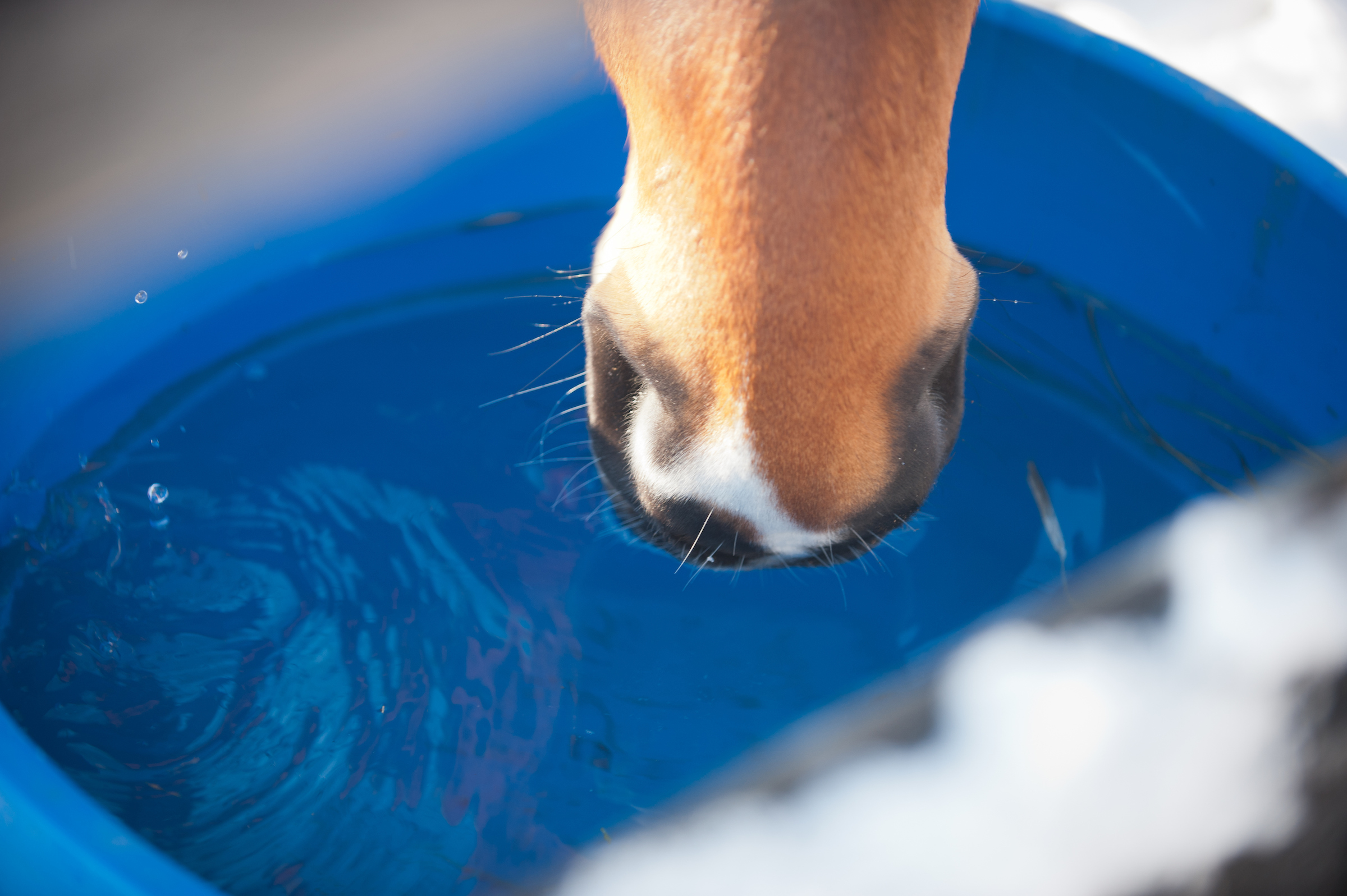
A reader asks: I often worry that my horse isn’t drinking enough. How much water should he be consuming each day and how can I ensure that he gets the amount he needs? What are signs that indicate he isn’t getting enough?
Lisa Borzynski, DVM, has the answer:
Water is the most essential nutrient for your horse, and fresh, clean, cool water must always be available to him. Dehydration can lead to poor performance, lethargy, colic, kidney damage, collapse and even death. Unfortunately, there are people who intentionally withhold water at shows to quiet their horses. This is an extremely dangerous practice and never appropriate. In addition to harming the horse, withholding water can lead to yellow cards and fines if you are caught.
Water makes up about 70 percent of a horse’s total body weight, and maintaining this balance is essential. The average horse will drink 5 to 15 gallons per day or about 1 gallon per 100 pounds of body weight. Broodmares need even more—about 20 gallons per day to produce milk for their foals.
One of the most important factors determining water intake is dry matter intake, for instance, how much forage your horse is eating. Horses sweat up to 2 to 3 gallons per day, so how hard your horse works also has a significant effect and may triple the water requirements. Heat, humidity and health status also have an effect.
Monitoring your horse’s water intake is important to detect potential changes in health. Buckets are the best way to monitor for changes. If you use automatic waterers, they should be checked daily to make sure they are functioning properly. It may take a new horse some time to figure out how to use an automatic waterer, so horses who have not used one before should have water buckets available until they are seen drinking water (and swallowing it, not just playing in it) from the automatic waterer. Ironically, thirst does not always correlate with dehydration, so your horse may not drink when he needs it the most.
Waterers, tanks and buckets must be cleaned regularly to prevent build-up of algae, scum and mosquito larvae. If you are unsure of the water quality, have it tested. Occasionally, wells have high levels of bacteria or nitrates that can cause illness.
You can monitor your horse’s hydration by evaluating the following:
- His gums, which should be moist and pink
- His eyes and flanks, which should not be sunken
- The skin on his neck, which should snap back when pinched
- His breathing pattern, which should be even and regular—not panting
- The capillary refill of his gums. This can be evaluated by pressing your thumb on the horse’s gums to blanch out the skin, then counting the number of seconds until the color returns. It should take less than two seconds.
In the winter, horses will drink less water, which will decrease feed consumption resulting in less energy for the horse. It may also lead to feed impactions of the intestines. It is important to prevent freezing of tanks and buckets by using water heaters or warm water. Check the water several times daily to make sure it isn’t frozen, or, if using electric heaters, that the horse is not getting a mild shock when drinking. The water should be kept between 45 and 60 degrees Fahrenheit at all times. Snow is not an appropriate water source.
Providing free-choice trace mineralized salt can encourage your horse to drink. If your horse does not use his salt block, consider adding 1 tablespoon of table salt to his grain once or twice daily. If your horse still refuses to drink, apple juice, electrolytes, Kool-Aid, molasses or even alfalfa pellets may be added to one bucket to encourage water consumption but be sure to have one bucket of plain water as well. This is also useful when traveling to flavor the water in new places.
When traveling to shows, clinics or other public places, keep biosecurity in mind. Do not allow your horse to drink out of common tanks or use a dirty bucket to collect water from a common area. Do not use other horses’ water buckets unless they have been cleaned and disinfected with bleach. Lastly, do not put the end of a hose directly into your buckets to fill, but instead hold the water above the bucket.
With appropriate care and a little effort, you can ensure that your horse gets the amount of water he needs.
Lisa Borzynski, DVM, is a 1993 graduate of the School of Veterinary Medicine at the University of Wisconsin and a veterinarian at the Wisconsin Equine Clinic and Hospital specializing in sporthorse medicine and lameness. She is also an FEI veterinarian, working as part of the veterinary team for the first week of the 2018 World Equestrian Games in the sports of eventing, dressage, para-dressage and endurance. An active competitor on the eventing and hunter/jumper circuits, she has also competed in dressage. She is based in Oconomowoc, Wisconsin.
This article was originally published in the Winter 2018 issue of Practical Horseman.









